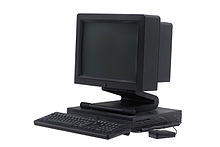NeXTstation
 NeXTstation computer, monitor, keyboard, and mouse | |
| Developer | NeXT |
|---|---|
| Manufacturer | NeXT |
| Type | Workstation computer |
| Release date | September 18, 1990[1] |
| Introductory price | US$4,995 (equivalent to $11,600 in 2023) NeXTstation US$7,995 (equivalent to $18,600 in 2023) NeXTstation Color US$6,500 (equivalent to $15,200 in 2023) NeXTstation Turbo |
| Discontinued | 1993 |
| Operating system | NeXTSTEP, OPENSTEP, NetBSD (limited support) |
| CPU | Motorola 68040 |
| Memory | 8 MB - 32 MB 8 MB - 128 MB (Turbo) |

NeXTstation is a high-end workstation computer developed, manufactured, and sold by NeXT from 1990 until 1993. It runs the NeXTSTEP operating system.
Overview
[edit]The NeXTstation was released as a more affordable alternative to the NeXTcube at about US$4,995 or about half the price. Several models were produced, including the NeXTstation (25 MHz), NeXTstation Turbo (33 MHz), NeXTstation Color (25 MHz) and NeXTstation Turbo Color (33 MHz). In total, NeXT sold about 50,000 computers (not including sales to government organizations), making the NeXTstation a rarity today.[2]
The NeXTstation originally shipped with a NeXT MegaPixel Display 17" monitor (with built-in speakers), keyboard, and mouse. It is nicknamed "the slab", since the pizza box form factor contrasts quite sharply with the original NeXT Computer's basic shape (otherwise known as "the cube").
The Pyro accelerator board increases the speed of a NeXTstation by replacing the standard 25 MHz processor with a 50 MHz one.[3][4] There was also a very rare accelerator board known as the Nitro; between 5 and 20 are estimated to have been made. It increased the speed of a NeXTstation Turbo by replacing the standard 33 MHz processor with a 40 MHz one.[5]
John Carmack developed the PC Game Doom on a NeXTStation Color.[6]
After NeXT ceased manufacturing hardware in 1993, Canon Computer Systems (a subsidiary of Canon Inc.) acquired the rights to the design of and patents pertaining to the NeXTstation.[7] They later released the Object.Station, an x86-based workstation using the NeXTstation design, in 1994.[8][9] Canon had been a large stakeholder in NeXT since 1989.[9]
Specifications
[edit]- CPU: Motorola 68040, 25 MHz or 33 MHz (Turbo)
- Memory: 8 MB (12 MB for NeXTstation Color, 16 MB for NeXTstation Turbo Color)
- NeXTstation: Eight 30-pin SIMM slots (up to 32 MB)
- NeXTstation Color: Eight 72-pin SIMM slots (up to 32 MB)
- NeXTstation Turbo/Turbo Color: Four 72-pin SIMM slots (up to 128 MB)
- Display resolution: 1120 × 832 px
- Color Depth:
- Digital signal processor: Motorola 56001 @ 25 MHz (16-bit, 44.1 kHz, stereo, 24 KB RAM, upgradable to 576 KB)
- Speaker built into the monitor
- Input/Output:
- Floppy internal connector
- SCSI internal connector
- SCSI-2 external connector (MD50)
- DSP port (DA-15)
- NeXTstation/Turbo: MegaPixel Display port (DB-19)
- NeXTstation Color/Turbo Color: Display port (13W3)
- Proprietary NeXT Laser Printer port (DE-9)
- Two RS-423 serial ports (Mini-DIN 8)
- 10BASE-T and 10BASE-2 Ethernet
- Media: 3.5 in 2.88 MB floppy disk drive
- Storage: hard disk from 105 MB, 250 MB, 340 MB, 400 MB to 4 GB (Larger sizes may work but the OS cannot use partitions larger than 4 GB)
- Operating System: NeXTSTEP, OPENSTEP. NetBSD supports some of the NeXTstation's hardware.
- Peripherals:
- Size/Weight: 39.8 (W) × 36.5 (D) × 6.4 (H) cm / 6 kg (13 lb)
See also
[edit]- Previous, emulator of NeXT hardware
- NeXT Computer
- NeXTcube Turbo
- NeXT character set
References
[edit]- ^ Webster, Bruce F. (January 1991). "Next on the Agenda". Macworld. pp. 160–166. Retrieved 2 May 2024.
- ^ "NeXTstation". Lowendmac.com. Retrieved 2012-02-08.
- ^ Spherical Solutions, Pyro Installation & Ordering
- ^ Spherical Solutions, Pyro 50 MHz Accelerator Card
- ^ NeXT Nitro Information Archived April 24, 1999, at the Wayback Machine
- ^ Quora (2016-09-01). "Why John Carmack Chose NeXT For Developing 'Doom' And Other Favorites". Forbes. Retrieved 2024-01-30.
- ^ Staff writer (March 10, 1994). "Canon Computer Systems Forms Advanced Technology Unit in the US for NeXTstation, PowerHouse Boxes". Computer Business Review. New Statesman Media Group. Archived from the original on November 27, 2021.
- ^ Staff writer (n.d.). "Canon Object.Station". Old-Computers.com. Archived from the original on August 3, 2021.
- ^ a b Staff writer (March 2, 1994). "Canon Computer to Ship NextStation". Los Angeles Times. Bloomberg Business News. Archived from the original on November 27, 2021.

